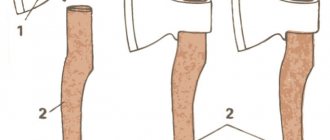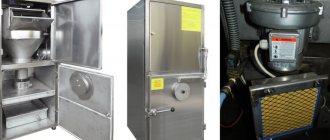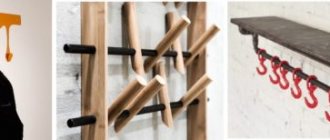An ordinary person thinks like this: if he doesn’t have something, he can buy it. A simple and straightforward approach that can only be accomplished if you have enough money in your pocket.
The DIY master has a slightly different opinion: if something doesn’t exist, it can be done.
And really, why spend money on something if you can do it yourself?
Very often this concerns tools and devices for car repair and maintenance.
Let's take, for example, a rolling jack. Yes, you can always buy the first mechanism you come across on the market, paying 1500-2000 rubles for it. But will you be sure of its reliability?
Practice shows that there are things on which it is better not to skimp. And a rolling jack is just that case.
If you buy a good jack from a reliable manufacturer - the toad is pressing, then if you have scraps of metal, you can make it yourself.
Moreover, you can immediately kill two birds with one stone. A homemade rolling jack will be much cheaper than branded models, but at the same time, more reliable than cheap Chinese analogues.
In this article, we will take a closer look at 4 interesting ideas from home craftsmen on how to make a rolling jack for a car with your own hands. If you like any of the designs, take note!
Types of jacks
There are three main types.
Mechanical jack. The car is lifted by pressing the handle. They are used quite rarely because they require some physical effort. The advantage is that they take up little space;
Hydraulic jack. Similar to the first option, but here you need to apply less physical force. All processes for lifting a car are carried out using liquids;
Pneumatic jack. Lifting is carried out thanks to compressed gas. Does not require any physical effort.
Note!
Wood burning for beginners: tips and secrets for burning pictures
Plasticineography - interesting options for creating pictures from plasticine on cardboard for children
DIY scrapbooking for beginners: what it is and how to do it. What you need to create a beautiful album or notebook (photo + video)
Working principle of pneumatic lift
A pneumatic jack works using the properties of compressed air. In the sealed chamber, into which the air pumped by the compressor enters, high pressure is gradually created.
Rubber cushions that expand under the action of compressed air rest against the load and gradually raise it to a predetermined height. At the end of the work, the air is released, the pressure inside the cushions decreases and the load is smoothly lowered.
In the process of repairing a car, service station specialists and car enthusiasts use a variety of options for pneumatic lifts - from rolling pneumatic jacks to polymer inflatable cushions and home-made structures.
Rack jack
The stability of this type of jack is determined by the strength of the fixation and the supporting platform.
To make it, take 2 pipes and welding. The finished product should resemble a stripped-down pyramid. After this, take a steel sheet, half a centimeter thick. Cut out 2 jack bases.
Drill a hole at the top and weld a nut there. You also need to drill a hole at the bottom. After this, insert a spiral there for rotation.
You can make small repairs and upgrades to this jack yourself. Install the cable, and it will serve as a winch if necessary.
These options are the simplest when making jacks with your own hands. Let's hope they will help you solve your pressing problems. No nail, no rod for you.
Classification of pneumatic jacks
Pneumatic lifts that are used in the repair of various vehicles can be divided into four types:
- portable;
- rolling;
- ditch;
- platforms.
Portable type jacks
Portable pneumatic jacks are a rubber or polymer cylinder with strong elastic walls. To lift the vehicle, this cylinder is filled with air, which is pumped by a compressor, or exhaust gas from the vehicle's exhaust pipe.
Despite the fact that this design looks quite flimsy, it is able to provide a lifting force of about 3...4 tons. At the same time, the time it takes to lift the car does not exceed 2...3 minutes.
In addition, portable pneumatic jacks:
- do not require maintenance, since they have no wearing parts;
- can be used even in cases where there is no flat hard surface under the car.
Rolling tackles
A rolling-type pneumatic jack is a trolley on wheels equipped with an elastic air cushion and locking elements that ensure the immobility of the structure after installing it under the car.
Air spring jacks provide lifting of the car to a height of up to 50 cm.
To hang a vehicle, a rolling jack is installed under its bottom, after which it is connected to a high-pressure compressor. Using a compressor that forces air into the air spring allows the jack to raise the car to the required height in a few seconds.
Ditch
A ditch pneumatic lift (crossbeam) is necessary in cases where it is necessary to adjust the wheel alignment angles or perform other types of repair work for which one of the vehicle axles needs to be suspended.
Its use allows you to create additional space in the repair area, which makes the repair more comfortable. In addition, the traverse can move along the axis of the inspection hole, so it can be placed in any place convenient for the car mechanic. Mount the traverse on an inspection hole or post lift. On the market you can find models with a lifting force exceeding 4 tons.
Structurally, the ditch lift is a frame with a lifting beam and a powerful air spring. At the same time, the locking mechanism makes it easy to fix the lifting beam at the required height.
For frame cars, the design provides quick-release extensions with replaceable rubberized heels. When lifting the car, the entire load is transferred to the frame. This jack is equipped with a reinforced three-section air spring with special reinforcing belts in rubber casting.
Pneumatic platforms
The pneumatic platform is designed to quickly lift a wheeled vehicle to a height convenient for high-quality tire mounting.
Using such a platform, you can hang the entire chassis of the car and service all 4 wheels at the same time.
At the same time, in addition to tire fitting work, other types of minor repairs can be carried out, such as, for example, replacement:
- ball joints;
- steering tips;
- brake pads, etc.
Using a pneumatic platform, you can lift the car to a height of about 400...500 mm. In this case, the device is equipped with a special safety stopper, the lever of which must be set to the load securing position upon completion of lifting.
Photos of do-it-yourself jacks
Please repost
0
Specifications
A pneumatic jack has a certain set of technical characteristics.
Among them the main ones are:
- load capacity, t - no more than 4;
- load lifting height, cm - 35...75 cm;
- pick-up height, cm - no more than 15 cm;
- operating pressure, atm - from 2 to 9.
These parameters may vary slightly depending on the type and classification of a particular air jack.
Some nuances
A hydraulic jack is the most common type of lifting mechanism. It has a large load capacity. Such devices are used at power plants, oil refineries and other industrial organizations. Most often, hydraulic lifts are used to lift cars in auto repair shops and tire shops.
Hydraulic lifting mechanisms periodically require repair and maintenance. The last thing is that it is necessary to top up the liquid leaking through the seals. It is necessary to monitor the technical condition of all components of the jack.
However, it is not the case. If you had a jack and it broke, you need to make a new one. Of what? You can take the old one as a basis and try to update it, i.e. Thus, make a new device from the previous one. Stages of work:
- You need to unscrew the fasteners.
- Next, you need to remove the piston and fluid release valve.
- After these manipulations, you need to inspect the main parts of the hydraulic jack. If any element is damaged, it should be replaced.
- The lifting mechanism must be cleared of debris and foreign elements. The cylinder also needs to be washed.
- The rubber band must be inspected. If it is damaged, it should be replaced.
- The final step will be to assemble the hydraulic jack. It is done in reverse order.
After you have been able to make the jack and the lift is assembled, you need to check its functionality. If the mechanism does not work, the oil may need to be checked and, if necessary, replaced.
The role of oil in a hydraulic lifting mechanism
Portable straightening jack included in the set.
Oil is an essential component of a hydraulic jack. With its help, the process of lifting various loads occurs. If there is not enough oil in the device, the device will not work. To change the oil, you need to follow two basic steps.
First you need to drain the used fluid; to do this, you need to unscrew the oil tank cap. Next, you should wash the lifting mechanism. This must be done using a special flushing liquid; it can be purchased at any hardware store.
Liquid is poured into the mechanism, pumped and drained.
Diamond jack drawing.
This procedure should be carried out 2-3 times. Washing the jack is a simple operation, but it takes a lot of time.
After cleaning the hydraulic lifting mechanism, you can begin adding new oil. It needs to be filled to a certain level. In this case, the lift must be in the down position. To lower the rod, you need to turn the valve screw to the “drain” position. Next, close the oil tank cap and pump the liquid 5 times. After this procedure, add oil and tighten the plug again. It is necessary to pump until the lubricant of the mechanism reaches the required level and bubbles do not form on its surface.
Their presence significantly reduces the efficiency of the mechanism. Often air gets into the housing due to lack of oil.
To correct this situation, you need to take the following steps. First you need to open the oil tank cap, as well as the bypass valve. Then you need to quickly pump the mechanism several times. When performing this procedure, air bubbles from the working area enter the oil tank. The plug from the bypass valve and the oil container can be closed.
Advantages and disadvantages
Among the advantages inherent to pneumatic jacks, users note:
- simplicity and ease of use
- high load capacity;
- minimum pick-up height;
- large lifting height, ensuring trouble-free repair work;
- lack of physical effort to lift the load;
- a large support area, which ensures high lifting reliability and stability of the mechanism and, in addition, does not damage the bottom of the vehicle;
The disadvantages of pneumatic jacks include:
- the possibility of damage to the elastic polymer or rubber walls of pneumatic cylinders and cushions;
- impossibility of use at low temperatures - air spring walls at ambient temperatures below -10°
- the durability of elastic materials from which cylinders and air bags are made is significantly less than that of metal parts of analogues.
Selection criteria when purchasing
The domestic market of equipment and accessories for car repairs offers a large number of different lifting mechanisms, among which pneumatic jacks occupy a relatively small niche.
Experts advise car enthusiasts when choosing a pneumatic jack to pay special attention to:
- the amount of carrying capacity, which must be at least 200...300 kg greater than the weight of the vehicle being lifted;
- lifting height;
- pick-up height, which should not be greater than the vehicle’s ground clearance;
- the maximum permissible pressure in air bags, based on the fact that low-pressure bags are only suitable for lifting passenger cars.
In addition, when choosing a pneumatic jack, you need to clearly understand what it is needed for. For example, if you have to take it with you on a trip, then it should be light, mobile and compact, but when using a pneumatic jack in the garage, you can purchase a more bulky, but multifunctional unit.
When choosing a pneumatic jack for your car, pay attention to the manufacturers of this type of equipment. Keep in mind that only high-quality equipment makes it possible to repair a car quickly and comfortably. After all, if the materials from which the pneumatic chambers and hoses are made are not afraid of punctures and cuts, then the pneumatic jack will serve you for a long time.











